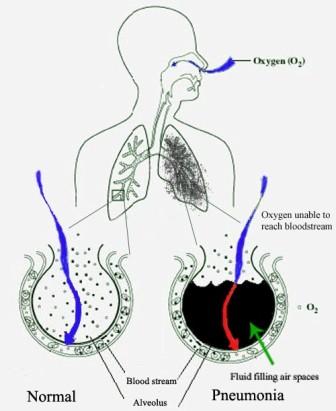Pneumonia history and symptoms
|
Pneumonia Microchapters |
|
Diagnosis |
|---|
|
Treatment |
|
Case Studies |
|
Pneumonia history and symptoms On the Web |
|
American Roentgen Ray Society Images of Pneumonia history and symptoms |
|
Risk calculators and risk factors for Pneumonia history and symptoms |
Editor(s)-in-Chief: C. Michael Gibson, M.S., M.D. [1] Phone:617-632-7753; Associate Editor(s)-In-Chief: Priyamvada Singh, M.D. [2]
Overview
People with pneumonia often have a productive cough, fever, shaking chills, shortness of breath, pleuritic chest pain, hemoptysis, headaches, diaphoresis, and clammy skin. Other possible symptoms are loss of appetite, fatigue, blueness of the skin, nausea, vomiting, mood swings, andjoint pains or muscle aches. In elderly people manifestations of pneumonia may not be typical. They may develop a new or worsening confusion or may experience unsteadiness, leading to falls. Infants with pneumonia may have many of the symptoms above, but in many cases they are simply sleepy or have a decreased appetite.

History and Symptoms
Common Symptoms
- Dyspnea
- Productive cough (greenish or yellow sputum)
- Fever (high grade) with sweating, chills, and rigor
- Pleuritic chest pain
- Rapid, shallow breathing
Less Common Symptoms
Elderly
The manifestations of pneumonia, like those for many conditions, might not be typical in older people. They may instead experience:
- Delirium
- Falls
- Hypothermia